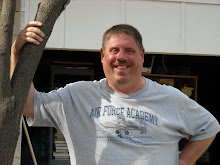


When I first joined the squadron, it was based at the Benton Municipal Airport in the "terminal" building. You can see this building as it exists today in the photos above. There have been several homes for Franklin County, but this building was the most enduring during my time. The building was constructed in the early '60's and consists of one large 12' x 25' common room, two offices, bathrooms, and a utility room accessible from an outside door. Not much but the squadron made do and thrived there for many years. Our drill pad is shown here also. That is the ramp that in the late 70's and early 80's usually had anywhere from 1-5 aircraft tied down there. After the bottom fell out of the coal market and most of the mines in the area shut down, the number of airplanes based there dropped and you usually don't see them tied down unless they are staying overnight in town.
Different airport managers and FBO's have made changes over the years. The common area used to be L-shaped until one manager decided to close it off to make the second office. He also put up a partition in the north end of the common room to put in a counter and window for selling logbooks and other pilot supplies. A later manager tore this out but left the second office enclosed. Over the years, some of the furniture has come and gone. When I first joined the squadron, all of the furniture was government or school surplus and of 1950's vintage. Some of this disappeared over the years, but there are still tables and chairs that were there when I joined in 1977.
As I said, many airport managers and FBO's have been at the airport over the years. However, when I joined CAP and for several years afterward the manger was a man named Al Bays. He was retired and lived on Washington Street about a mile from the airport. Al pumped the fuel and kept the place clean and uncluttered. I often went out to the airport on Sunday afternoons just to hang out(maybe bum an airplane ride) and Al would be there as he was most days. But on Sundays, you could always count on Al to be sitting in a comfortable chair with an old AM radio on the table next to it listening to the St. Louis Cardinals playing. Al loved the Cardinals. I think that after Al most of the others paled by comparison.
Note: In front of the airport building is and old rusty flag pole. If you look carefully, you will note that it curves slightly to the right at the top. This bend is the result of us running a cadet's pants up the flag pole during one of our overnight activities at the airport. I guess we should have taken the pants off him before we tried to run them up.








